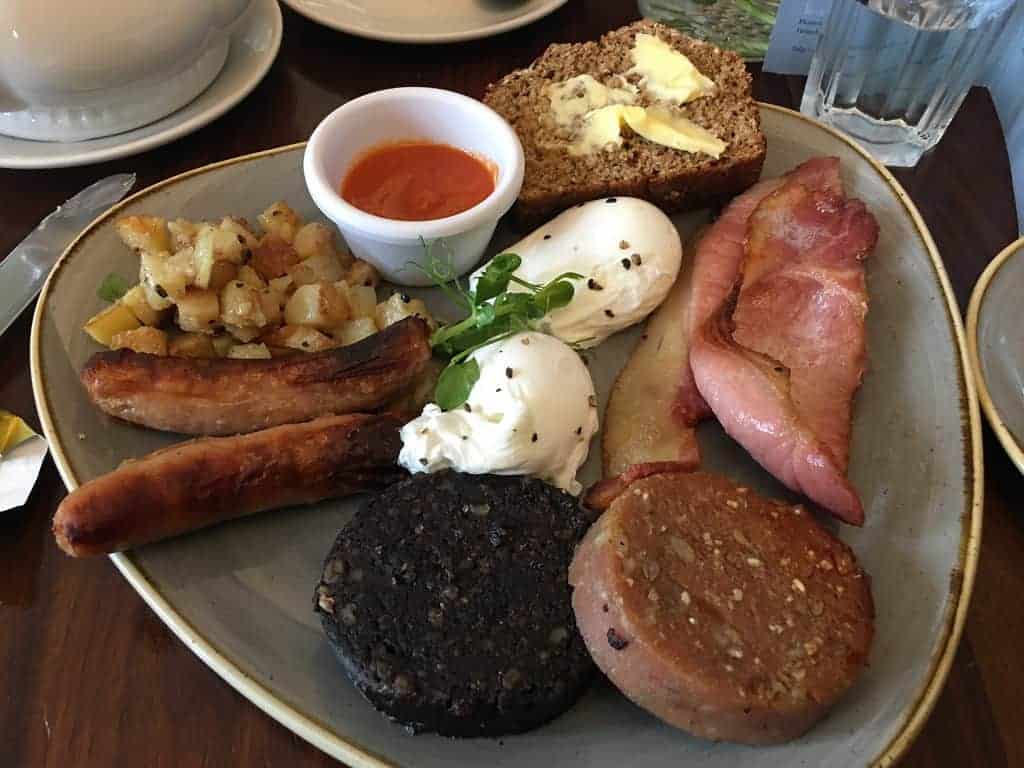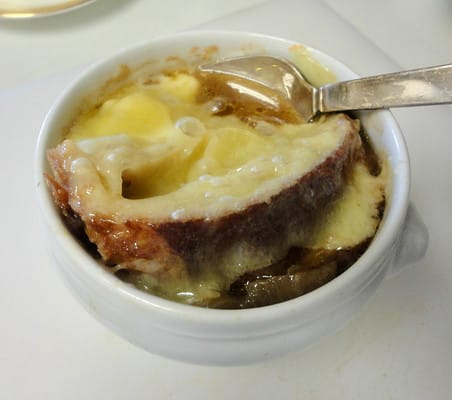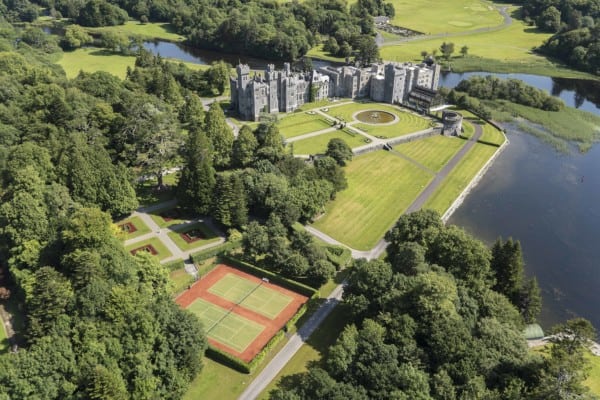My partnership with Travel-Wise is growing almost as fast as this fantastic travel resource is. When I publish at www.travel-wise.com, my Editor sends me an article for Chewing The Fat. Today’s post is from a writer named Natasha Devine. In it, Natasha not only gives a survey of all that’s on offer in Ireland today, she points the way from what to eat to where to find it. And she finishes up with a recipe for one of Ireland’s most celebrated meals: The Full Irish Breakfast. So take it away Natasha and thanks so much for your contribution to Chewing The Fat.
A highlight of many travels is the food! Where you ate, the new foods you tried, the cultural differences, discovering new spices… and Ireland is no exception. If you’re looking to sample some traditional Irish fare, there are some staples you’ll have to try.
Classic Irish Dishes to Try
Surf
Being an island, Ireland has access to plenty of fresh fish and shellfish so it’s no surprise that many Irish dishes feature a variety of seafood. Vegetarians can even get a taste of the ocean as seaweed is also often used in recipes or eaten fresh out of the package.
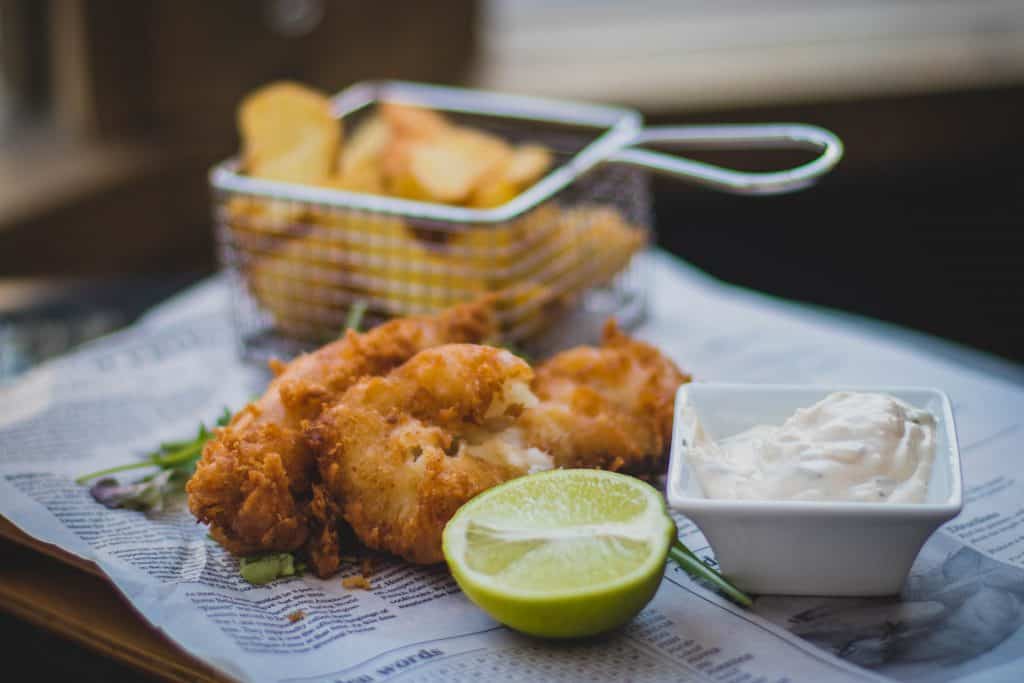
Fish & Chips Fish and chips are a UK standard and no stranger to pub menus around the world. There are about 11,000 chip shops throughout the UK and Ireland, so no matter where you’re traveling in the United Kingdom, you’ll have plenty of opportunities to tuck into this classic dish. While cod remains the most popular fish used, any white fish such as haddock or halibut will do the trick. The fish is coated in a crispy beer-batter and served with thick cut chips (fries), accompanied by mushy peas or a curry sauce if you wish. While no one knows precisely where or when fish and chips originated, they are undeniably an Irish classic.
Shellfish Cockles and mussels may be the first thing to come to mind, especially if you’re familiar with the popular song about Molly Malone — but Ireland has plenty more to offer including oysters, prawns, and various types of crab. Anyone visiting Ireland in September may have the chance to attend the Oyster Festival in Galway. Or if you pop down in March, the Dublin Bay prawns have a festival of their own as well.
Dulse Seaweed can be found in many dishes throughout Ireland including omelets, scones, pasta, and sauces, just to name a few. The most popular seaweed used is called Dulse. It’s a deep reddish-brown color and often comes in soft, chewy flakes. Dulse can be eaten right from the package as a salty snack (the way my Granda often enjoyed it) or it can be steamed and used in recipes.
Turf
If seafood isn’t really your flavor, there are plenty of alternative options without straying from classic Irish traditions.
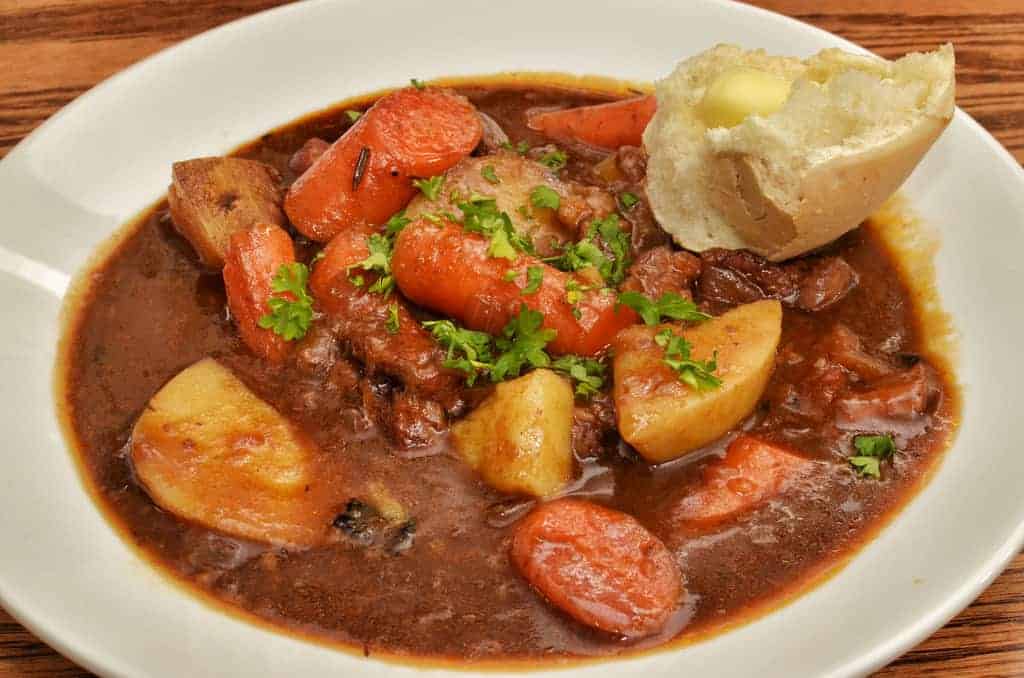
Irish Stew The best way to warm up after a brisk walk is with a lovely bowl of Irish stew. It’s a delicious combination of lamb, potatoes, and root vegetables that’s sure to fill you up. While lamb or mutton is the popular choice of meat, beef may also be used. This hearty dish is said to be the backbone of Irish food and isn’t to be passed over. Add a slice of soda bread with Irish creamery butter and you’ll be smitten.
Beef & Guinness Pie There had to be at least one dish featuring the famous dark stout of Ireland. Guinness and beef are a match made in heaven — add in some pie pastry and you can’t go wrong. Beef and root vegetables are simmered in broth and Guinness for about two hours soaking up the Guinness flavor and creating a thick and delicious sauce. The filling is then baked into a flaky pie crust. You may encounter pies with mushrooms, bacon, or other variations as each family likely has their own way of making a beef pie, but either way, it’s going to be delicious!
Black and White Puddings Black pudding, also known as blood pudding, isn’t as frightening as it may sound. It isn’t the sweet dessert that you may think of, but instead is a type of sausage that is popular throughout the UK and Ireland. It’s comprised of pork blood, meat, fat, oats, and bread or potato fillers. White pudding is the same but without the use of blood. These traditional sausages are often served with breakfast.
Breads
Soda Bread This simple bread uses baking soda instead of traditional yeast, classifying it as a quick bread because it starts to rise immediately, compared to the time it takes for yeast bread to rise. It also requires no kneading and a minimum amount of mixing the ingredients is recommended. Traditional Irish soda bread has only four ingredients: flour, baking soda, salt, and buttermilk. Variations can be made to include a wholemeal flour and occasionally raisins. This variation is referred to as wheaten bread and is usually sweetened, whereas soda bread is savory.
Potato Bread Similar to soda bread, potato bread is an easy to make classic. Potato flour or potatoes replace a portion of the wheat flour; it’s a great way to use up leftover mashed potatoes! When baked in a loaf, it looks similar to soda bread but potato farls or potato cakes (also called fadge) are also an option. Potato farls are made when the dough is cut into quarters or squares and rolled flat to be fried. This form of potato bread is one of the key items in an Ulster fry or “full Irish” breakfast.
Boxty This traditional Irish potato pancake looks like a thick crepe and contains a mixture of mashed and grated potatoes fried in butter. A boxty is different from potato bread in that it does not contain flour or other ingredients. What you end up with is a delicious combination of textures that is part pancake and part hash brown. The ways to serve it are endless as it they can be topped with whatever you desire and served with any meal you fancy.
Where to Eat in Ireland
The locals recommend:
- Point Bar, Magilligan
- Harbour Bistro, Portrush
- Amici, Portstewart
- Harry’s Shack, Portstewart
- Clenaghans, Craigavon
- Buba, Belfast
- EDŌ Restaurant, Belfast
- Boojum, several locations
- Molly’s Yard, Belfast
- The Muddlers Club, Belfast
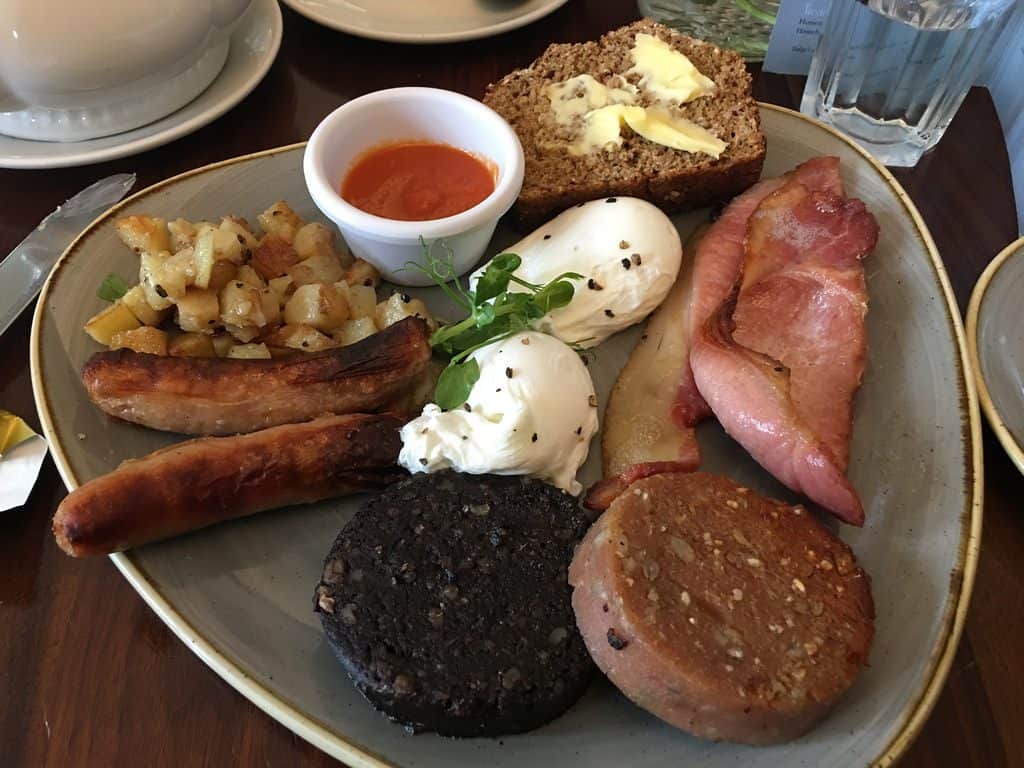 Presenting….The Full Irish Breakfast
Presenting….The Full Irish Breakfast
Breakfast is arguably the most important meal of the day. Especially if you’ve got a full day of exploring the emerald countryside of Ireland ahead of you, or if you’ve woken after a night of downing pints at the local pub. Whatever the need, the “Full Irish” breakfast — also called an Ulster fry — has you covered.
This meal was traditionally made to fill the bellies of those with a full day of heavy duty work ahead of them. Now it is typically enjoyed on a sleepy Sunday morning. The full spread consists of bacon, black and white puddings, sausages, eggs, vegetables — typically tomatoes and mushrooms — and potatoes or potato bread all fried up in creamery butter.
You won’t be hard pressed to find a spot that offers a traditional Irish fry, but there are some places that boast a better meal than others including:
- Shannon’s Corner, Ballyshannon, Co. Donegal
- Maggy Mays, Belfast
- Slims Healthy Kitchen, Belfast (for an Irish fry with less calories)
- Henry’s Bar & Restaurant, Cashelgarron, Co. Sligo
- Tony’s Bistro, Cork
- Primrose Cafe, Derry
- Queen of Tarts, Dublin
- Finnegan, Galway
- Cafe Creme, Newcastle, Co. Down
If you’d rather take a crack at it yourself (is there anything better than waking up to the sound of sizzling butter and the smell of bacon?) either as a chance to experience the local produce or impress the family, “Discovering Ireland” has provided the perfect recipe for a traditional “Full Irish” breakfast. Dig in!
The Full Irish Breakfast
Discover Ireland's recipe will bring the genuine article to your table..a full Irish Breakfast to be proud of.
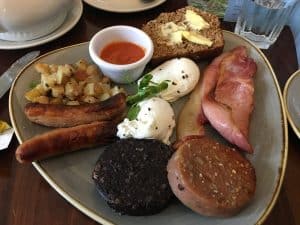
Ingredients
- Pack of Irish bacon or rashers
- Pack of Irish local sausages
- Black and white pudding
- 400g of baked beans
- 4 eggs
- Mushrooms
- 4 medium tomatoes, halved
- Potato Farl or boxty or some cold cooked potato leftovers from yesterday's dinner (traditionalists only)
Directions
- Step 1 Place a frying pan (skillet) over a medium heat and melt a knob of good Irish creamery butter. Add the rashers and fry them until they are cooked to your liking (Irish style is cooked, but not crispy). Set aside on a warmed plate in the oven to keep warm and fry the sausages in the frying pan. Once cooked, add them to the rashers on the warmed plate.
- Step 2 Meanwhile, slice the puddings, halve the tomatoes, and chop up the mushrooms and add to the frying pan, frying until they are browned on all sides. Again, once finished add to the warmed plate in the oven.
- Step 3 While you are frying the puddings, mushrooms, and tomatoes, in a separate saucepan you can heat the baked beans.
- Step 4 If going the traditional route and using potato bread or indeed using cold cooked potatoes, add it to the frying pan and cook as to your preference.
- Step 5 After finishing with the vegetables and puddings, one can next fry the eggs in the same frying pan. Once finished with the eggs, one can now add all the cooked ingredients together and serve on four plates.
- Step 6 To Serve: Serve with some thick slices of homemade Irish bread loaf, be it soda or brown bread. For an extra touch, set out a little side dish of homemade jam and Irish creamery butter as a sweet topping for the bread to be eaten afterwards with your tea.
- Step 7 Wash down with a strong cup of Breakfast tea and a healthy glass of orange juice.
